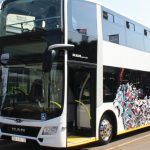Toyota: the people’s champion

South Africa’s light commercial vehicle sector is a significant contributor to the country’s economy, not only in terms of the number of minibuses and bakkies produced locally, but also in terms of the volumes of vehicles and parts exported to destinations in Africa and other areas of the world.
It’s fitting, therefore, that Toyota South Africa Motors (TSAM) has decided to bolster facilities at its Durban plant to accommodate increased production of its Hiace Ses’fikile minibus taxi, as well as to set up an operation for exporting Hilux kits to Kenya.
At an event last month to mark the official launch of the new ventures, Ebrahim Patel, Minister of Trade, Industry and Competition, described Durban as the heart of the continent’s taxi industry, with more than 80 000 Hiaces produced at Toyota’s factory since assembly began there in 2012. He added that if any nameplate deserved to serve as brand of choice for the people of KwaZulu-Natal, Toyota should top the list.
“If each of those taxis opened their doors to commuters right now, more than a million South Africans would be able to climb in,” he said, praising the brand’s decision to increase the amount of local content in the latest version of the Hiace from 38 to 44 percent.
“In line with the South African Automotive Masterplan, the government has ambitions to lift production of vehicles built in South Africa to 1,4-million units a year by 2035 – representing one percent of global volumes. By then, the aim is to have increased the amount of local content in vehicles to 60 percent,” he said.
Among the economic rewards for reaching those targets Patel listed a doubling of the number of employees in the automotive value chain. Currently, the sector directly employs about 350 000 people in KwaZulu-Natal alone, according to Andrew Kirby, CEO of TSAM.
In his address, Kirby said the Hiace plant represented a total investment of more than R1 billion – the most recent expansion accounting for R454 million, which has increased production capacity to 14 000 units a year, up 37 percent compared with the number originally assembled from semi knocked-down kits imported from Japan.
“In terms of turnover, South Africa’s minibus-taxi industry represents a R90-billion a year business,” he said. “Fifteen-million passengers a day use its services.”
Kirby said an additional 80 jobs had been created following the latest development, which he described as a major vote of confidence in the capability of the South African automotive industry. In addition, another 20 people had been employed in a venture which sees knocked-down kits of Hilux bakkies exported to Kenya for assembly in that country.
“There’s been a shift in industrialisation policies in several African countries,” Kirby said. “South Africa is well positioned as a hub to support motor industry initiatives and develop trade links with other parts of the continent. We’ve invested about R20 million in building the 25 modules that are required for the Hilux project – all parts are supplied to Kenya in 580 boxes packed here at TSAM.”
According to Kirby, the local economy and customers in Kenya stand to benefit from the initiative – the latter will be able to buy vehicles at a cheaper price than they are currently paying – while the Hiace project is expected to pump about R422 million annually into KwaZulu-Natal’s coffers.
Published by
Focus on Transport
focusmagsa




